Purification and Chemical Characterization of a Potent Acaricide and a Closely Related Inactive Metabolite Produced by Eurotium rubrum C47
Abstract
1. Introduction
2. Results
2.1. Purification of the Acaricidal Compound
2.2. Resolution of Eleven Compounds by Semipreparative and Analytical HPLC
2.3. Monitoring of the Purification of the Active Compound by Thin Layer Chromatography
2.4. Structure Determination of Compounds 9b and 9c
2.5. Production of Flavoglaucin and Aspergin by E. rubrum C47 in Different Solid Media
2.6. Production of Flavoglaucin and Aspergin by Different Eurotium Strains
2.7. Formation and Release of Flavoglaucin to the Medium in Liquid Cultures
3. Discussion
4. Materials and Methods
4.1. Strains and Culture Conditions
4.2. Determination of the Acaricidal Activity of Extracts and Liquid Culture Samples
4.3. Statistical Studies
4.4. Purification of the Acaricidal Compounds
4.5. Thin Layer Chromatography
4.6. Structure Elucidation of Compounds by Mass Spectrometry and Nuclear Magnetic Resonance
4.7. Quantification of Flavoglaucin and Aspergin
5. Conclusions
Supplementary Materials
Author Contributions
Funding
Acknowledgments
Conflicts of Interest
References
- Krantz, G.W.; Walter, D.E. (Eds.) A Manual of Acarology, 3rd ed.; Texas Tech University Press: Lubbock, TX, USA, 2009; pp. 1–807. [Google Scholar]
- Vytřasová, J.; Přibáňová, P.; Marvanová, L. Occurrence of xerophilic fungi in bakery gingerbread production. Int. J. Food Microbiol. 2002, 72, 91–96. [Google Scholar] [CrossRef]
- Greco, M.; Kemppainen, M.; Pose, G.; Pardo, A. Taxonomic characterization and secondary metabolite profiling of Aspergillus section Aspergillus contaminating feeds and feedstuffs. Toxins 2015, 7, 3512–3537. [Google Scholar] [CrossRef]
- Schickore, J. Cheese mites and other delicacies: The introduction of test objects into microscopy. Endeavour 2003, 27, 134–138. [Google Scholar] [CrossRef]
- Brückner, A.; Heethoff, M. Scent of a mite: Origin and chemical characterization of the lemon-like flavor of mite-ripened cheeses. Exp. Appl. Acarol. 2016, 69, 249–261. [Google Scholar] [CrossRef] [PubMed]
- Johnson, R.M. Honey bee toxicology. Annu. Rev. Entomol. 2015, 60, 415–434. [Google Scholar] [CrossRef] [PubMed]
- Garrido, P.M.; Porrini, M.P.; Antúnez, K.; Branchiccela, B.; Martínez-Noël, G.M.; Zunino, P.; Salerno, G.; Eguaras, M.J.; Ieno, E. Sublethal effects of acaricides and Nosema ceranae infection on immune related gene expression in honeybees. Vet. Res. 2016, 47, 51. [Google Scholar] [CrossRef] [PubMed]
- Larche-Mochel, M.; Doignon, J.; Dakkali-Hassani, M.H. A clinical case concerning a producer of Bayonne Ham: Allergy to acarids. Arch. Mai. Prof. Med. Trav. Secur. Soc. 1993, 54, 437–438. [Google Scholar]
- Armentia, A.; Fernández, A.; Pérez-Santos, C.; De la Fuente, R.; Sánchez, P.; Sánchez, F.; Méndez, J.; Stolle, R. Occupational allergy to mites in salty ham, chorizo and cheese. Allergol. Immunopathol. 1994, 22, 152–154. [Google Scholar]
- Matsumoto, T.; Hisano, T.; Hamaguchi, M.; Miike, T. Systemic Anaphylaxis after Eating Storage-Mite-Contaminated Food. Int. Arch. Allergy Immunol. 1996, 109, 197–200. [Google Scholar] [CrossRef]
- Di Loreto, V.; Ottoboni, F.; Cantoni, C. Acarofauna del prosciuto crudo stagionato. Ind. Aliment. 1985, 12, 1011. (In Italian) [Google Scholar]
- García, I.; Díez, V.; Zumalacárregui, J.M. Changes in proteins during the ripening of Spanish dried beef “cecina”. Meat Sci. 1997, 46, 379–385. [Google Scholar] [CrossRef]
- Rohlfs, M.; Albert, M.; Keller, N.P.; Kempken, F. Secondary chemicals protect mould from fungivory. Biol. Lett. 2007, 3, 523–525. [Google Scholar] [CrossRef] [PubMed]
- Janssens, T.K.S.; Staaden, S.; Scheu, S.; Mariën, J.; Ylstra, B.; Roelofs, D. Transcriptional responses of Folsomia candida upon exposure to Aspergillus nidulans secondary metabolites in single and mixed diets. Pedobiologia 2010, 54, 45–52. [Google Scholar] [CrossRef]
- Rohlfs, M. Fungal secondary metabolite dynamics in fungus–grazer interactions: Novel insights and unanswered questions. Front. Microbiol. 2015, 5, 788. [Google Scholar] [CrossRef][Green Version]
- Zhao, Y.; Abbar, S.; Phillips, T.W.; Williams, J.B.; Smith, B.S.; Schilling, M.W. Developing food-grade coatings for dry-cured hams to protect against ham mite infestation. Meat Sci. 2016, 113, 73–79. [Google Scholar] [CrossRef]
- Zhao, Y.; Abbar, S.; Amoah, B.; Phillips, T.W.; Schilling, M.W. Controlling pests in dry-cured ham: A review. Meat Sci. 2016, 111, 183–191. [Google Scholar] [CrossRef]
- Ortiz-Lemus, J.F.; Campoy, S.; Martín, J.F. Biological control of mites by xerophile Eurotium species isolated from the surface of dry cured ham and dry beef cecina. J. Appl. Microbiol. 2020. [Google Scholar] [CrossRef]
- Arai, K.; Aoki, Y.; Yamamoto, Y. Asperinines A and B, Dimeric Tetrahydroan thracene Derivatives from Aspergillus ruber. Chem. Pharm. Bull. 1989, 37, 621–625. [Google Scholar] [CrossRef][Green Version]
- Li, D.-L.; Li, X.-M.; Li, T.-G.; Dang, H.-Y.; Proksch, P.; Wang, B.-G. Benzaldehyde Derivatives from Eurotium rubrum, an Endophytic Fungus Derived from the Mangrove Plant Hibiscus tiliaceus. Chem. Pharm. Bull. 2008, 56, 1282–1285. [Google Scholar] [CrossRef]
- Fathallah, N.; Raafat, M.M.; Issa, M.Y.; Abdel-Aziz, M.M.; Bishr, M.M.; Abdelkawy, M.A.; Salama, O. Bio-Guided Fractionation of Prenylated Benzaldehyde Derivatives as Potent Antimicrobial and Antibiofilm from Ammi majus L. Fruits-Associated Aspergillus amstelodami. Molecules 2019, 24, 4118. [Google Scholar] [CrossRef]
- Yoshihira, K.; Takahashi, C.; Sekita, S.; Natori, S. Tetrahydroauroglaucin from Penicillium charlesii. Chem. Pharm. Bull. 1972, 20, 2727–2728. [Google Scholar] [CrossRef][Green Version]
- Hamasaki, T.; Kimura, Y.; Hatsuda, Y.; Nagao, M. Structure of a new metabolite dihydroauroglaucin produced by Aspergillus chevalieri. Agric. Biol. Chem. 1981, 45, 313–314. [Google Scholar] [CrossRef][Green Version]
- Hubka, V.; Kolarík, M.; Kubatova, A.; Peterson, S.W. Taxonomical revision of Eurotium and transfer of species to Aspergillus. Mycologia 2013, 105, 912–937. [Google Scholar] [CrossRef] [PubMed]
- Hamasaki, T.; Fukunaga, M.; Kimura, Y.; Hatsuda, Y. Isolation and structured of two new metabolites from Aspergillus ruber. Agric. Biol. Chem. 1980, 44, 1685–1687. [Google Scholar]
- Chen, A.; Hubka, V.; Frisvad, J.C.; Visagie, C.M.; Houbraken, J.; Meijer, M.; Varga, J.; Demirel, R.; Jurjević, Ž.; Kubátová, A.; et al. Polyphasic taxonomy of Aspergillus section Aspergillus (formerly Eurotium), and its occurrence in indoor environments and food. Stud. Mycol. 2017, 88, 37–135. [Google Scholar] [CrossRef]
- Miyake, Y.; Ito, C.; Tokuda, H.; Osawa, T.; Itoigawa, M. Evaluation of flavoglaucin, its derivatives and pyranonigrins produced by molds used in fermented foods for inhibiting tumor promotion. Biosci. Biotechnol. Biochem. 2010, 74, 1120–1122. [Google Scholar] [CrossRef]
- Cary, J.W.; Harris-Coward, P.Y.; Ehrlich, K.C.; Mayungu, J.D.; Malysheva, S.V.; Saeger, S.D.; Dowd, P.F.; Shantappa, S.; Martens, S.L.; Calvo, A.M. Functional characterization of a veA-dependent polyketide synthase gene in Aspergillus flavus necessary for the synthesis of asparasone, a sclerotium-specific pigment. Fungal Genet. Biol. 2014, 64, 25–35. [Google Scholar] [CrossRef]
- Mulinti, P.; Allen, N.A.; Coyle, C.M.; Gravelat, F.N.; Sheppard, D.C.; Panaccione, D.G. Accumulation of ergot alkaloids during conidiophore development in Aspergillus fumigatus. Curr. Microbiol. 2014, 68, 1–5. [Google Scholar] [CrossRef]
- Lim, F.Y.; Ames, B.; Walsh, C.T.; Keller, N.P. Co-ordination between BrlA regulation and secretion of the oxidoreductase FmqD directs selective accumulation of fumiquinazoline C to conidial tissues in Aspergillus fumigatus. Cell Microbiol. 2014, 16, 1267–1283. [Google Scholar] [CrossRef]
- Keller, N.P. Translating biosynthetic gene clusters into fungal armor and weaponry. Nat. Chem. Biol. 2015, 11, 671–677. [Google Scholar] [CrossRef]
- Nies, J.; Ran, H.; Wohlgemuth, V.; Yin, W.-B.; Li, S.-M. Biosynthesis of the Prenylated Salicylaldehyde Flavoglaucin Requires Temporary Reduction to Salicyl Alcohol for Decoration before Reoxidation to the Final Product. Org. Lett. 2020, 22, 2256–2260. [Google Scholar] [CrossRef] [PubMed]
- Wilson, R.A.; Calvo, A.M.; Chang, P.K.; Keller, N.P. Characterization of the Aspergillus parasiticus delta12-desaturase gene: A role for lipid metabolism in the Aspergillus-seed interaction. Microbiology 2004, 150, 2881–2888. [Google Scholar] [CrossRef] [PubMed]
- Miyake, Y.; Ito, C.; Itoigawa, M.; Osawa, T. Antioxidants produced by Eurotium herbariorum of filamentous fungi used for the manufacture of karebushi, dried bonito (Katsuobushi). Biosci. Biotechnol. Biochem. 2009, 73, 1323–1327. [Google Scholar] [CrossRef] [PubMed]
- Kawai, K.; Mori, H.; Kitamura, J. The uncoupling effect of flavoglaucin, a quinol pigment from Aspergillus chevalieri (Mangin), on mitochondrial respiration. Toxicol. Lett. 1983, 19, 321–325. [Google Scholar] [CrossRef]
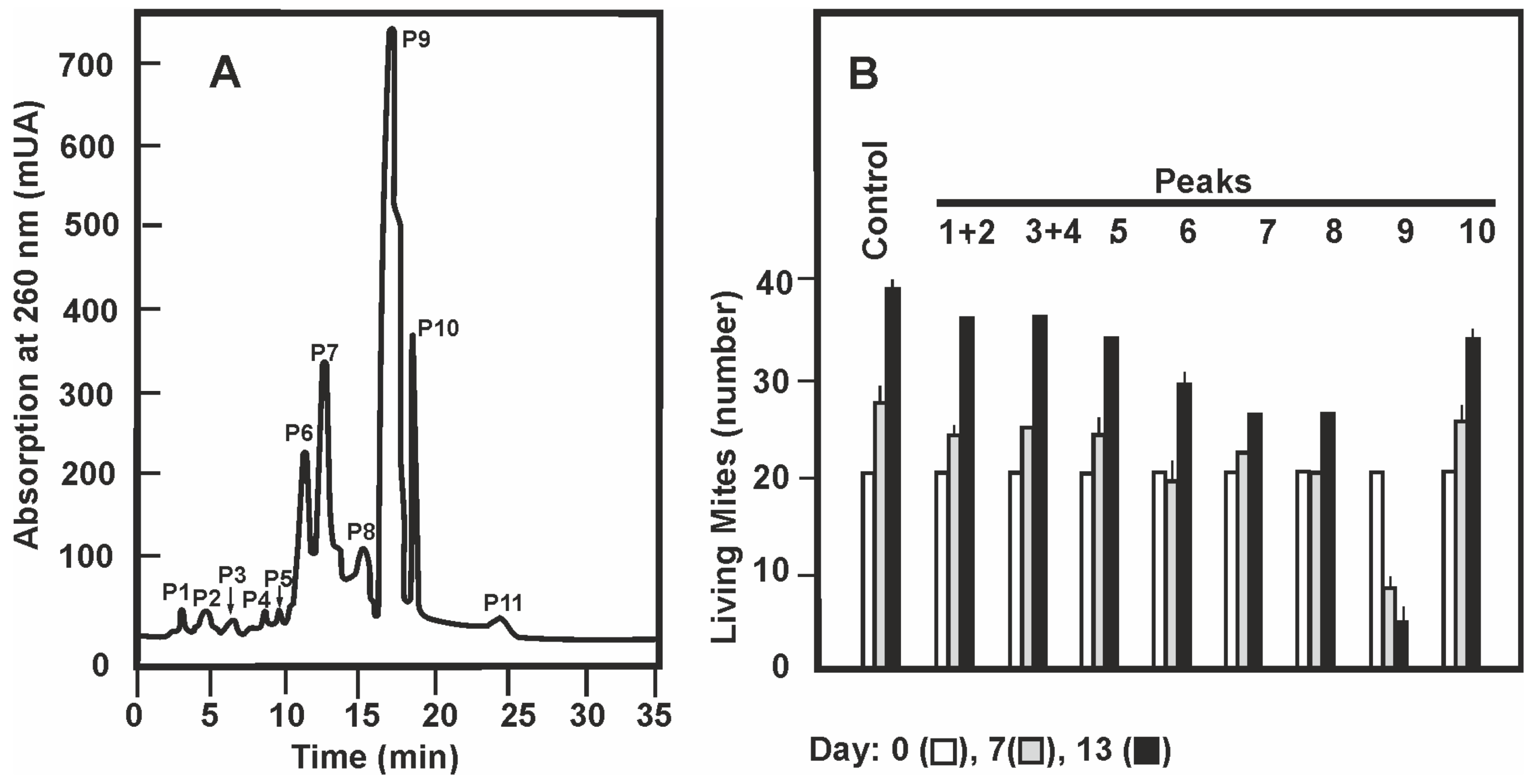
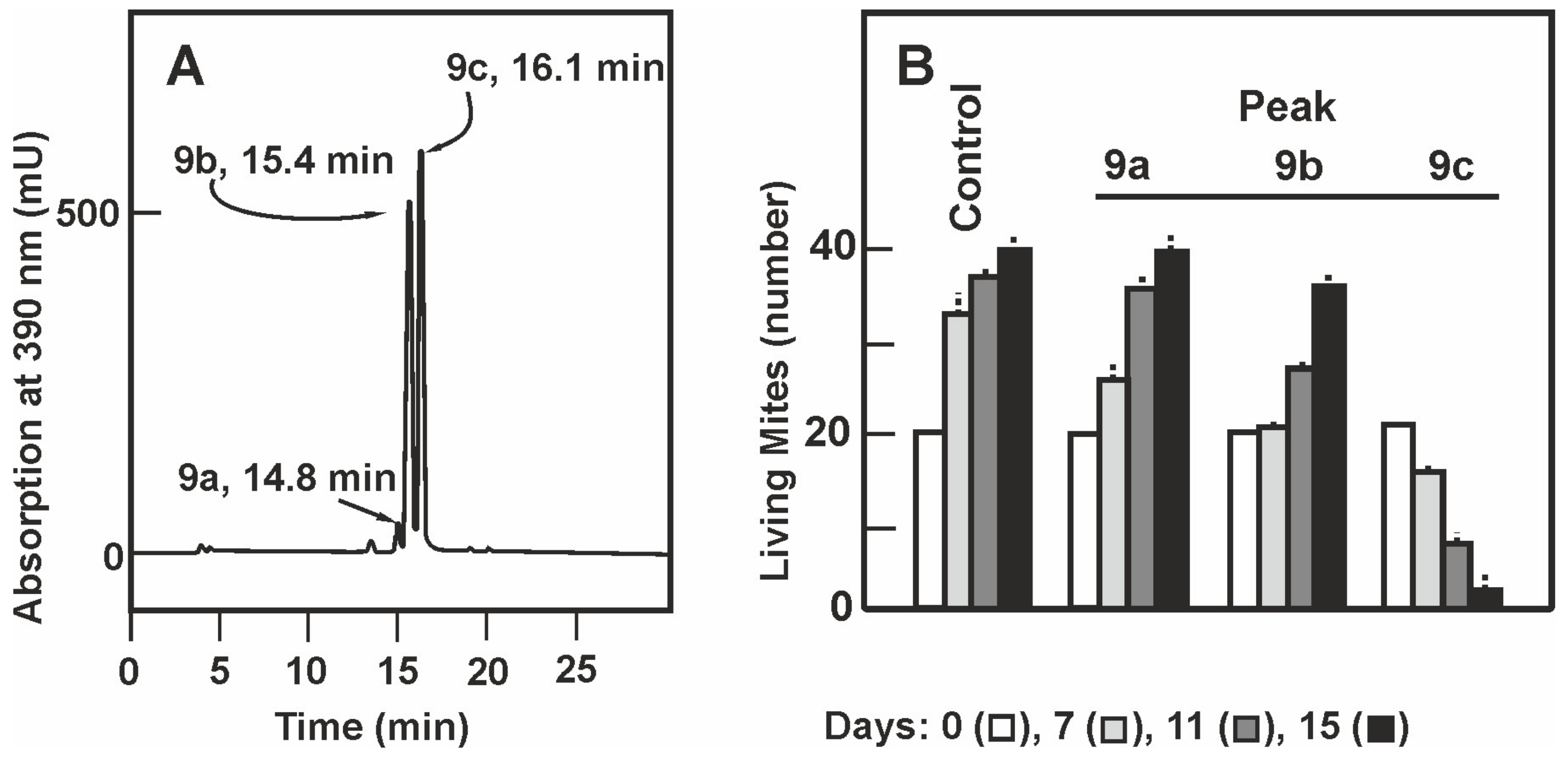
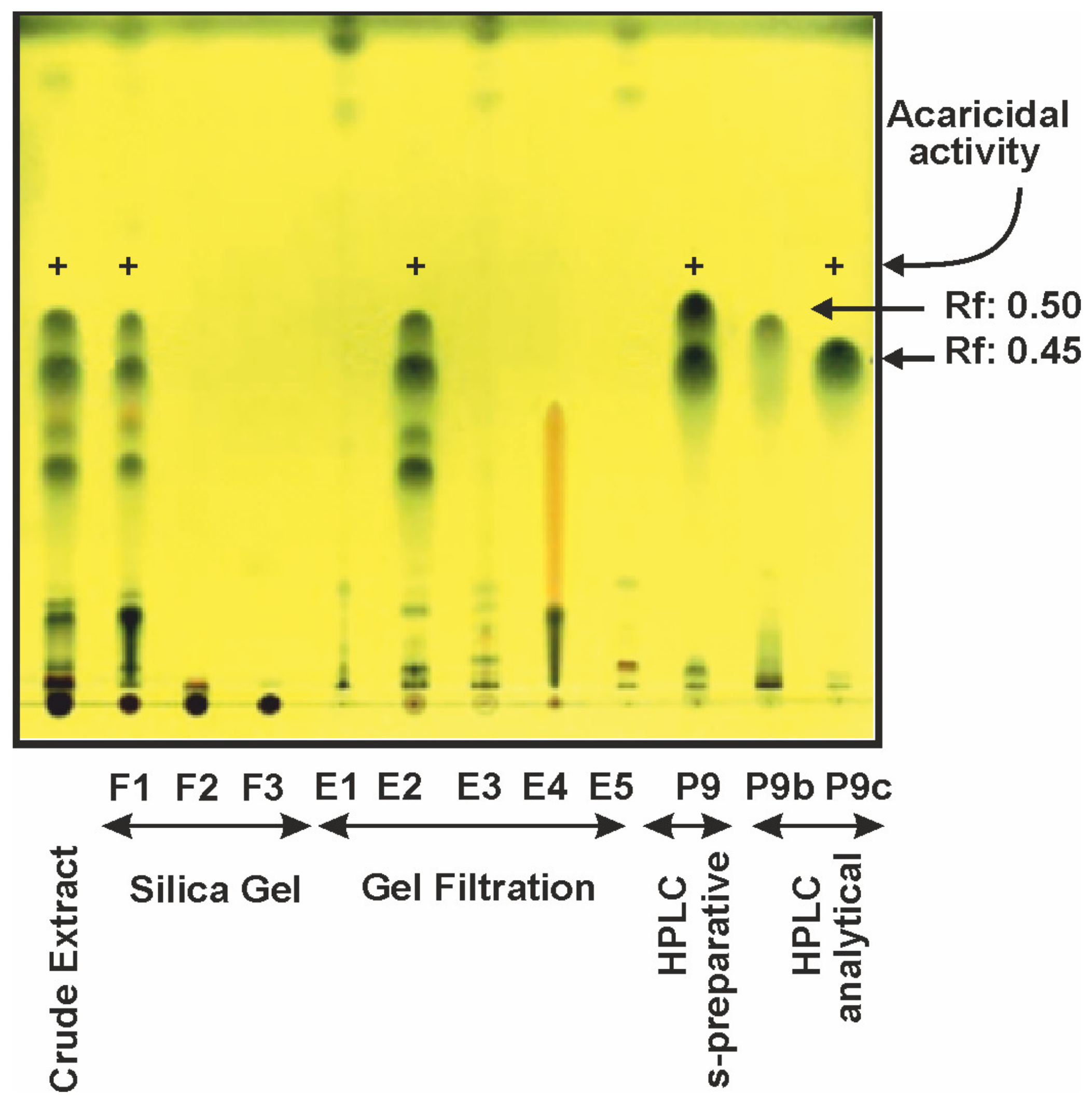

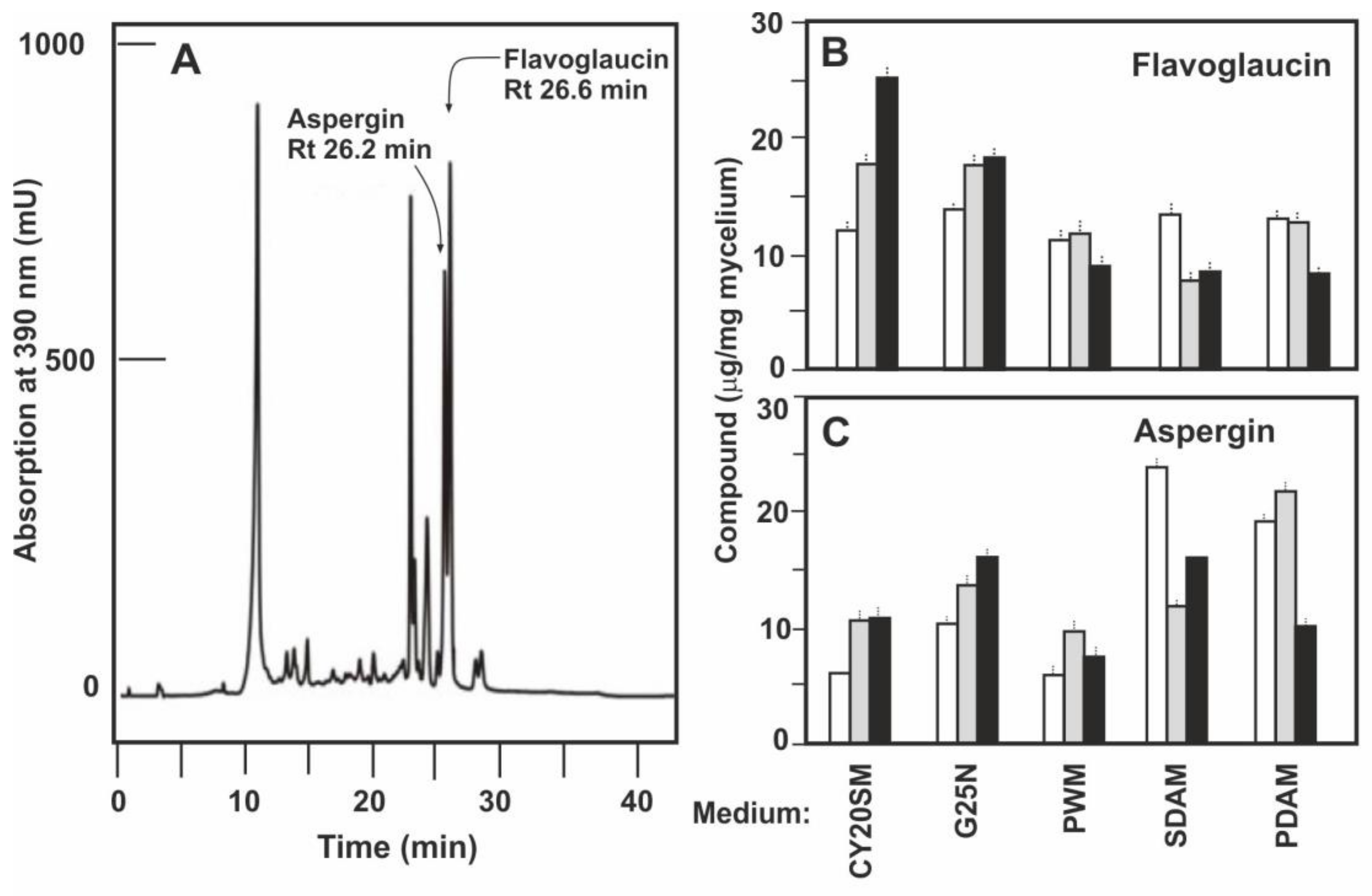
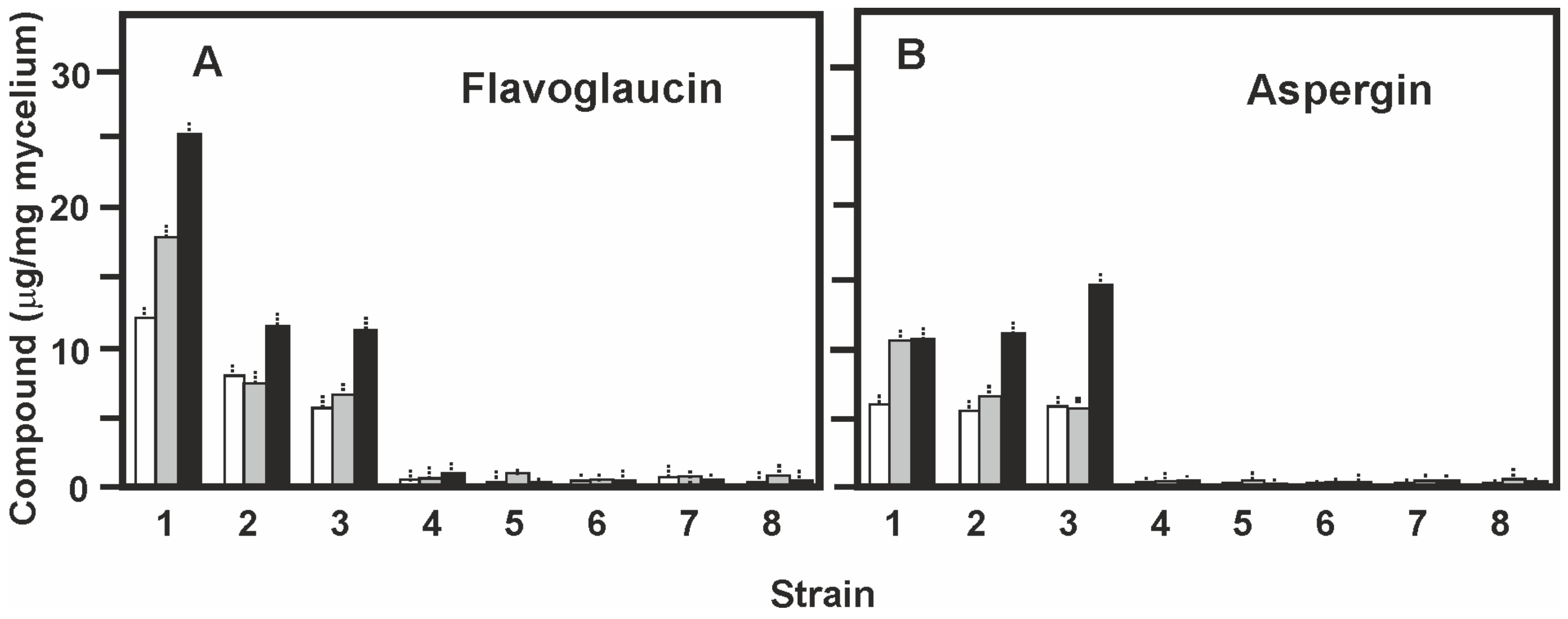
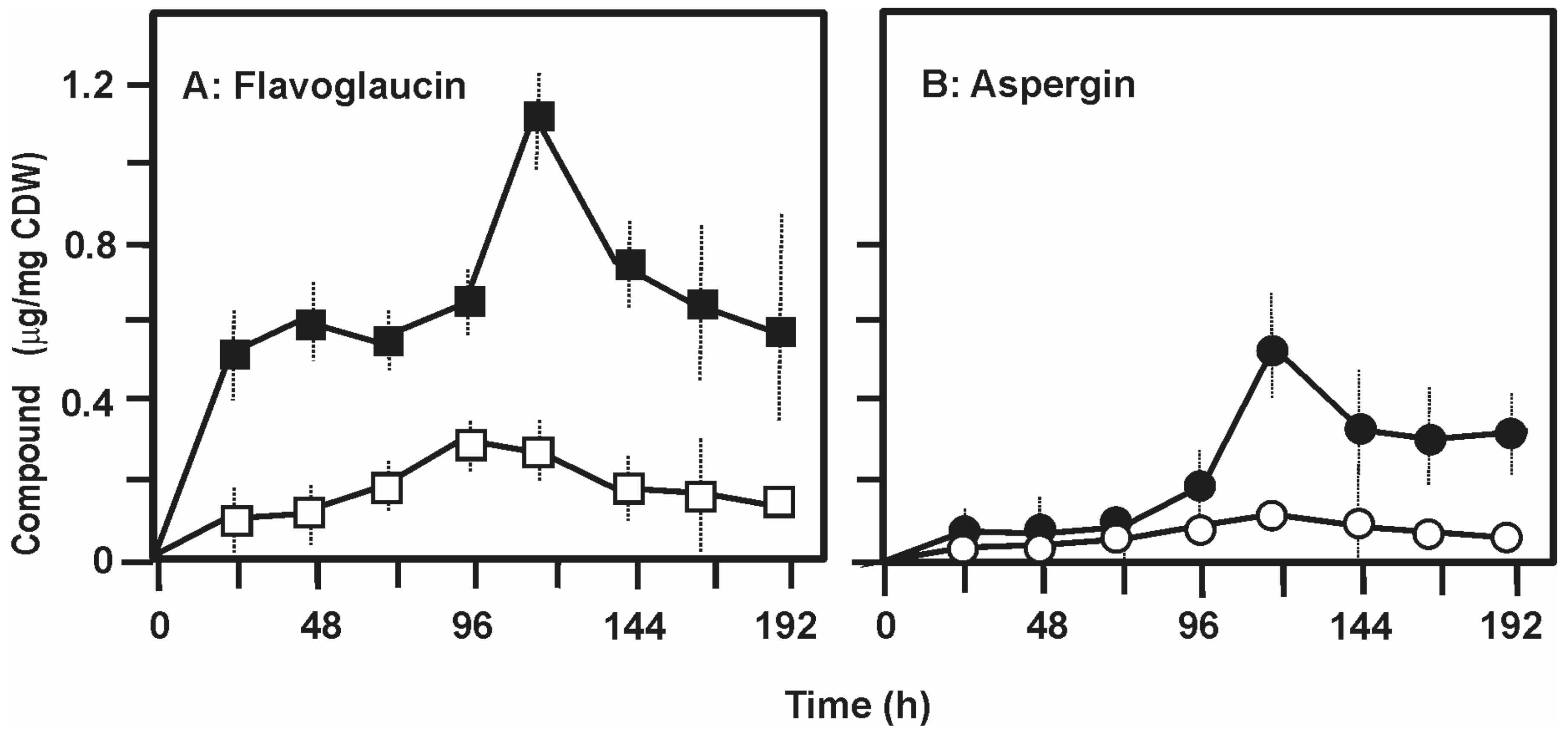
| C/H No | Flavoglaucin | Aspergin | ||
|---|---|---|---|---|
| 13C a | 1H a,b,c | 13C a | 1H a,b,c | |
| 1 | 195.8 | 10.25 s, 1H | 196.5 | 10.09 s, 1H |
| 2 | 117.5 | 117.3 | ||
| 3 | 128.7 | 130.6 | ||
| 4 | 145.2 | 145.0 | ||
| 5 | 125.9 | 6.88 s, 1H | 125.3 | 7.02 s, 1H |
| 6 | 128.7 | 128.7 | ||
| 7 | 156.0 | 11.92 s, OH | 155.4 | 11.73 s, OH |
| 8 | 24.2 | 2.88 t, 2H (J = 8.0) | 120.3 | 6.47 d, 1H (J = 14.0) |
| 9 | 32.2 | 1.56 m, 2H | 142.9 | 6.00 dt, 1H (J = 14.0, 6.8) |
| 10 | 29.4 | 1.30 m, 2H | 33.7 | 3.34 m, 2H |
| 11 | 29.8 | 1.38 m, 2H | 31.7 | 1.35 m, 2H |
| 12 | 32.0 | 1.26 m, 2H | 28.9 | 1.50 m, 2H |
| 13 | 22.8 | 1.28 m, 2H | 22.7 | 1.36 m, 2H |
| 14 | 14.3 | 0.87 t, 3H (J = 7.0) | 14.2 | 0.89 t, 3H (J = 6.9) |
| 15 | 27.2 | 3.29 d, 2H (J = 7.2) | 27.4 | 3.31 d, 2H (J = 7.3) |
| 16 | 121.4 | 5.58 m, 1H | 121.2 | 5.58 m, 1H |
| 17 | 134.1 | 134.2 | ||
| 18 | 18.0 | 1.70 s, 3H | 18.0 | 1.70 s, 3H |
| 19 | 26.4 | 1.76 s, 3H | 26.4 | 1.76 s, 3H |
Publisher’s Note: MDPI stays neutral with regard to jurisdictional claims in published maps and institutional affiliations. |
© 2020 by the authors. Licensee MDPI, Basel, Switzerland. This article is an open access article distributed under the terms and conditions of the Creative Commons Attribution (CC BY) license (http://creativecommons.org/licenses/by/4.0/).
Share and Cite
Ortiz-Lemus, J.F.; Campoy, S.; Cañedo, L.M.; Liras, P.; Martín, J.F. Purification and Chemical Characterization of a Potent Acaricide and a Closely Related Inactive Metabolite Produced by Eurotium rubrum C47. Antibiotics 2020, 9, 881. https://doi.org/10.3390/antibiotics9120881
Ortiz-Lemus JF, Campoy S, Cañedo LM, Liras P, Martín JF. Purification and Chemical Characterization of a Potent Acaricide and a Closely Related Inactive Metabolite Produced by Eurotium rubrum C47. Antibiotics. 2020; 9(12):881. https://doi.org/10.3390/antibiotics9120881
Chicago/Turabian StyleOrtiz-Lemus, José F., Sonia Campoy, Librada M. Cañedo, Paloma Liras, and Juan F. Martín. 2020. "Purification and Chemical Characterization of a Potent Acaricide and a Closely Related Inactive Metabolite Produced by Eurotium rubrum C47" Antibiotics 9, no. 12: 881. https://doi.org/10.3390/antibiotics9120881
APA StyleOrtiz-Lemus, J. F., Campoy, S., Cañedo, L. M., Liras, P., & Martín, J. F. (2020). Purification and Chemical Characterization of a Potent Acaricide and a Closely Related Inactive Metabolite Produced by Eurotium rubrum C47. Antibiotics, 9(12), 881. https://doi.org/10.3390/antibiotics9120881






